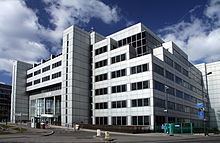 | ||
Bruce forsyth with the olympic torch at bbc white city
BBC White City, also known as the BBC Media Village (or W12 within the BBC), is a collection of six buildings occupying a 17-acre site at Wood Lane, White City in West London (W12). All formerly properties of the BBC, several have now closed, with only Broadcast Centre and the Lighthouse currently occupied by BBC staff. The site is a short distance down Wood Lane from the former BBC Television Centre.
Contents
The BBC have sold the majority of buildings on the site and it has been announced that Media Village will be renamed White City Place by new owners Stanhope and Mitsui Fudosan.
BBC White City
The first building on the site, BBC White City, was designed by architects Scott Brownrigg & Turner and was opened in 1990. Built on the site of the 1908 Franco-British exhibition, White City One was constructed on the location of the former White City Stadium (The Great Stadium) used for the 1908 Summer Olympics. The stadium was demolished in 1985 and parts of the Olympic swimming pool were also discovered when the foundations of the new building were laid.
The building was originally intended to be a new home for BBC Radio, replacing Broadcasting House. This plan was scrapped and the building instead became office space with fifty edit suites, various Television production teams, the Digital Switchover team, BBC Academy, the Children in Need charity and parts of Operations and HR, as well as a large restaurant.
It housed most of the BBC's current affairs and factual and learning programmes, such as Panorama, Top Gear (where it featured in a segment about the Peel P50), Watchdog and many others. The BBC vacated the building in March 2013 and sold it to developers. It has since been referred to as White City One to distinguish it from the wider site.
Architectural critic Jonathan Glancey wrote in The Guardian that by comparison to the "handsome, if timeworn ships of the line" such as Broadcasting House and Bush House, White City was "a tin-pot freighter, inefficient, ugly, and old before its time." Rachid Errtibi, a facilities coordinator at the BBC reflected that "most staff disliked the White City building for one reason or another [but] the building did have a unique character, and was flexible enough to accommodate any new departments at short notice - achieved simply and quickly by putting up a few glass partition panels and rearranging furniture, at minimum cost."
Development
Construction of the second phase of the development began in September 2001 and the site was officially opened in May 2004 and was known as the Media Village. It consists of five further buildings in addition to White City One - Media Centre, Broadcast Centre, Energy Centre, Garden House and the Lighthouse. The buildings were designed by Allies and Morrison Architects and Buro Happold and built by Bovis Lend Lease. In addition to BBC offices, the site included a post office, a Tesco Express, a Starbucks, a Davy's wine bar and several other retail outlets, many of which have now closed. To pay for construction costs, the BBC signed a 30-year deal with Land Securities Trillium, Britain's largest property developer.
The rear of Media Centre included gardens designed by Christopher Bradley-Hole. A poem Voices of White City by Poet Laureate Andrew Motion is inlaid into the paving in the piazza. The site featured artworks such as Simon Patterson's art wall in Broadcast Centre which is based on First World War dazzle camouflage and Yuko Shiraishi's mural in Media Centre reception. She was also responsible for the overall colour scheme in both buildings. Energy Centre features the Olympic Rings as a marker of the finishing line of the 1908 Olympic marathon, with a plaque unveiled by IOC president Jacques Rogge in 2005.
A further planned building, the Music Box, designed by Foreign Office Architects was scheduled for opening in 2006, but was cancelled before construction began. It would have been a concert hall and recording venue for the BBC Symphony Orchestra and Chorus, the BBC Concert Orchestra and the BBC Singers.
Occupants
The Media Centre was the global headquarters for the BBC's for-profit publishing subsidiary BBC Worldwide from 2008 until 2015, when it moved into the former BBC News annex of Television Centre. Media Centre also housed various non-broadcast divisions of the BBC which had been moved from central London to make way for the redevelopment of Broadcasting House. Media Centre was used for broadcasts of Watchdog and Rogue Traders as well as a filming location for The Thick of It.
A number of BBC Television-making departments were located in Media Centre following the vacating of Television Centre in 2013 including Comedy, Entertainment & Events and Factual. Media Centre and Garden House were vacated and closed on 10 July 2015 following the sale to Stanhope and Mitsui Fudosan. It was stated that the BBC received £87 million for the sale. Staff were relocated into Broadcast Centre, Broadcasting House, Grafton House and some to MediaCityUK in Salford. In 2004, it was intended that the Garden House and Lighthouse would be leased by independent production companies working with the BBC. At the time of its closure in July 2015, Garden House was mainly occupied by Atos and associated sub-contractors' teams following the sale of BBC Technology to Siemens in 2004.
Broadcast Centre continues to house BBC Design & Engineering staff, BBC Studios production staff, Marketing and Audiences staff and Ericsson Broadcast and Media Services (formerly Red Bee Media)'s digital television facilities from where channels including BBC One, Channel 4, Channel 5, BT Sport and many others are broadcast. The Energy Centre provides services to the entire site, and from early 2008 became home to the production team of Top Gear and the Top Gear magazine team. The One Show studio was located in the Energy Centre from 2007 to 2013 before moving to the newly-built Peel Wing of Broadcasting House.
